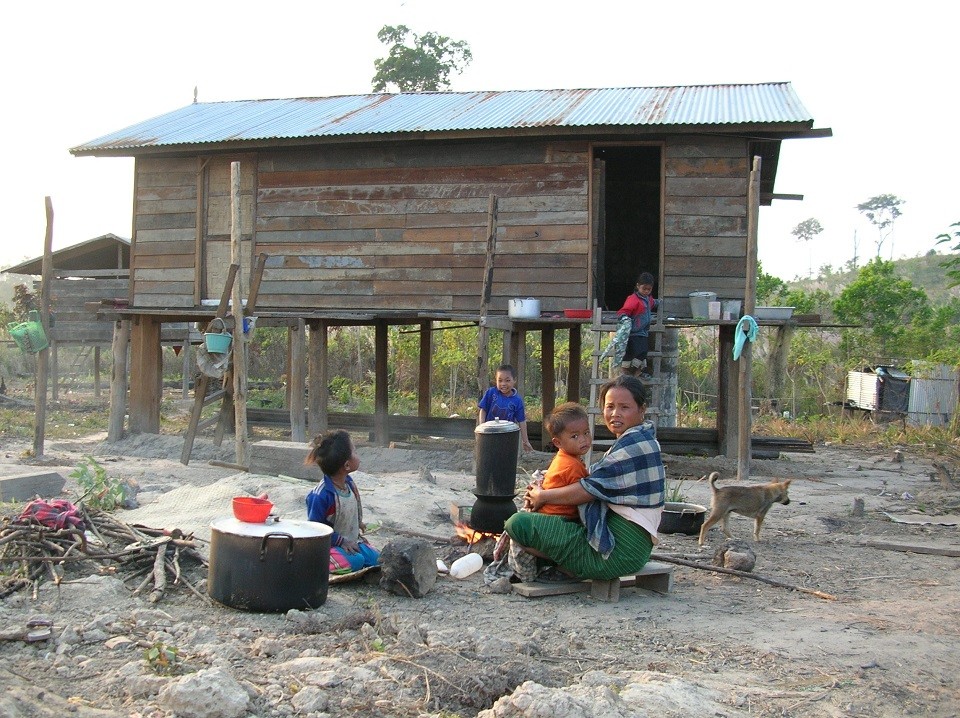
Family in the Nakai Plateau pilot village, photo: Andrew Preston
Fan Li
The Nam Theun 2 dam in Laos has failed to meet required human rights standards. By looking at two different reports assessing the project, this article will discuss if there is any progress in mitigating these issues. Nam Theun 2 Annual Update: Project Progress During 2013 (hereinafter as the update), is a report based on the developments in the implementation of the Nam Theun 2 (hereinafter as NT2) project during 2013, which is jointly conducted by a field-based team and International Financial Institutions, (hereinafter as IFIs), such as the World Bank and the Asian Development Bank. The update covers plenty of different issues related to NT2 project. Lao people’s Democratic Republic Nam Theun 2 Multipurpose Project: Twenty Third Report of the International Environmental and Social Panel of Experts (hereinafter as the report) is endorsed by the World Bank’s own independent Panel of Experts (hereinafter as POE) with two main foci – the resettlement process on the Nakai Plateau and the status of the Watershed Management and Protection Authority.
Though POE is supported and partially mandated by the World Bank, and the update is perceived to prove the project’s purported success of the bank, the report pointed out some loopholes of the resettlement process, indicating the project might not be as satisfactory as the bank considered. The reason why the author has chosen the update and the report to make a comparison is mainly because they both have touched upon the social aspects of the Nakai Plateau, but their arguments do not all the time back each other. Sometimes, interestingly, the attention should be paid to when they have reached contradictory conclusions based on the same or similar statistics. This article attempts to give a plausible explanation.
Poverty Reduction
According to the update, Nam Theun 2 has undeniably gained great economic achievements. After several years’ vigorous 8 percent economic growth, the Lao PDR economic growth was projected to moderate to 7.2 percent(still very high compared to the slow growth in the global economy) in 2014 largely due to the operation of the hydro-power dam. This was especially considering the impact of mining and construction, as well as the government budget tightening. However the economic effects are not the exclusive consideration to evaluate whether a dam is a success or not. In addition, radical economic growth may be beneficial for, but not always be the equivalent of, poverty reduction. The effects of such growth can be driven away by the results of inefficient institutions, corruption, the weak rule of law and excessive bureaucratic burdens in reality. The people are not the beneficiaries in each of the occasion. Environmental and social impacts are supposed to be taken into account. It would not be an easy mission to conclude or generalize the significance of a large dam, even though more and more related indicators are available.
In respect of social impact perspective, it is encouraging to see that more than $65 million has been spent so far to help resettle 6,300 people on the Nakai Plateau, providing 1,330 new houses with bathrooms and toilets, electricity and rainwater collection tanks; 330 water pumps; 120 kilometres of all-weather access roads; 32 schools and two health centres, as well as village meeting centres, warehouses and roofed markets. In 2013, their median consumption was three times the national poverty line, and 90 percent of children aged five to nine now attend schools, compared to 31 percent before resettlement. Child mortality has dropped to 50 per 1,000 from 120 per 1,000, with 90 percent of resettled children under five years old now immunized. Based on the detailed and accurate date above-mentioned, the update proudly claims that “most resettler households are significantly better off today than they were before the project”.
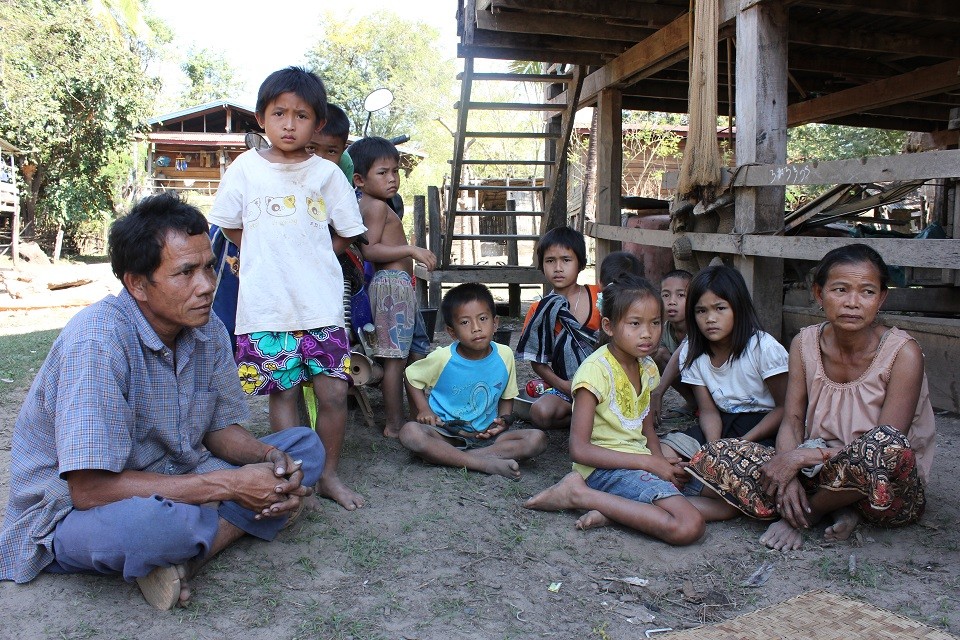
Resettled villagers, photo: Jonas Holmqvist
All of the measures mentioned above can without controversy pave the way for the achievement of the ultimate goal of poverty reduction. However, given the complexity of resettlement, these inspiring achievements may not be adequate for us to be satisfied permanently. After all, the relocation is a long-term project to maintain and further enhance the living standard of the affected residents for the sake of high level of sustainability, which is also deemed as a primary Concession Agreement principle. Besides, the report tells a different story. It states the sources of the relocated people’s income are vulnerable and fragile owing to the unsuccessful livelihood pillars. There is no doubt that the resettled have better infrastructure due to the project, including houses, electricity, roads, schools, and health centers, but simultaneously they also paid an enormous price of having lost their traditional livelihoods, like their access to their paddy and swidden fields, forests, and grazing lands. On the basis of the World Bank’s conclusion, land rights is “the key to reducing poverty”. Supposing the resettlers’ land rights cannot be guaranteed, it will be debatable whether the approaches of poverty reduction are genuinely effective or not. Moreover, the enhanced living conditions of those resettled who have been lifted out of poverty are not necessarily stable. Without continuous endeavours from the government and the developers, they are likely to fall back into poverty.
The World Bank’s rationale for supporting NT2 is that the government revenues will be used to reduce poverty. Whether or not the support from the World Bank could be justified depends on how the “money” is to be used. The update states that the World Bank has received reports on the allocation and expenditure of NT2 revenues by sector and by some projects including for activities such as teacher training, provision of school text books, rural health services, and electrification of rural villages. However, the IFIs have not received any formal reports on the use of revenues or audits thereof. It would be too arbitrary to claim that NT2 project fails to achieve its ultimate goal of poverty reduction completely, but at least there is a basis for reasonably questioning whether it has been be as successful as what was expected.
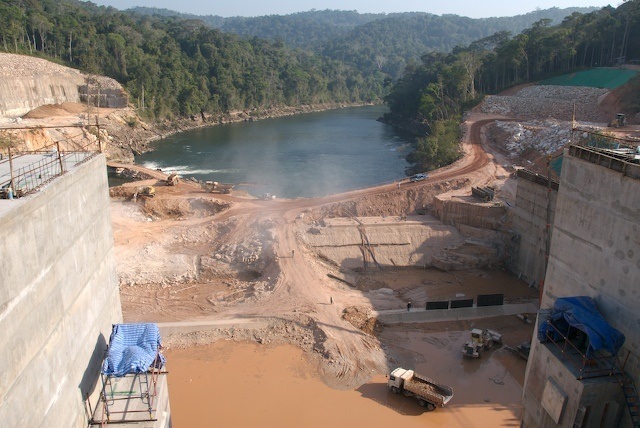
Downstream of Nam Theun 2 Dam, photo: Marcus Rhinelander
Since the Lao government is unwilling to disclose the related figures about the allocation of the revenues, it seems natural to suspect that a significant proportion of the revenues may not have gone towards poverty reduction. In addition, the Laotians cannot fully demand transparency and accountability due to the severe restrictions on civil and political freedoms in the country. The Government has been urged to correct this situation to comply with the requirements of NT2 Revenue Management Arrangement that progress reports on projects funded by NT2 revenues and accompanying financial reports should be submitted to the IFIs every six months. In addition, the audits are to be conducted annually. It remains unknown whether the government follows the request of the World Bank or not.
Struggling to grow enough food
POE has put out five pillars that make out the main basis of livelihood for the resettlers: livestock, fisheries, forestry, agriculture, and off-farm. Since the update does not touch upon the pillar of livestock, the comparisons will basically address the rest four pillars.
The significance of food for the resettlers is self-evident. The update optimistically predicted that the rice yields were coming in well above pre-resettlement average production level. To the contrary, the report argued that the so-called rice production boost relied on the technique of slashing and burning the vegetation on the lands with the lack of rain-fed padi. This technique can only work temporarily as the land would have to go into follow for several years after only two harvests. An alternative has to be found in order to guarantee a stable rice production without a wasteful use of the available land. According to the report, the villagers are still struggling to grow sufficient food.
Reasonably diverse fishery
In 2011, after an initial windfall period, the reservoir fisheries catches dropped and stabilized at a lower level, but it was still considered above the levels caught in rivers prior to the project. Though some of the fish species had undergone reductions, they maintained reasonably diverse. Consequently fish catches had stabilized ranging from 20-80 tons/month in 2012 and 2013. In 2014, comparatively, it was monitored by both villagers and the Village Fishery Association, that the catch levels were decreasing, which was not a resulted of too high fishery quota. In fact, it is the illegal fishing that steals resources from the relocated people, threatening the most successful pillar, especially important to the vulnerable and poor households. There are two types of illegal fishing – villages themselves were fishing in the protected areas, undermining the ecosystem; and outsiders competed with villagers, taking away the benefits reserved for resettlers.
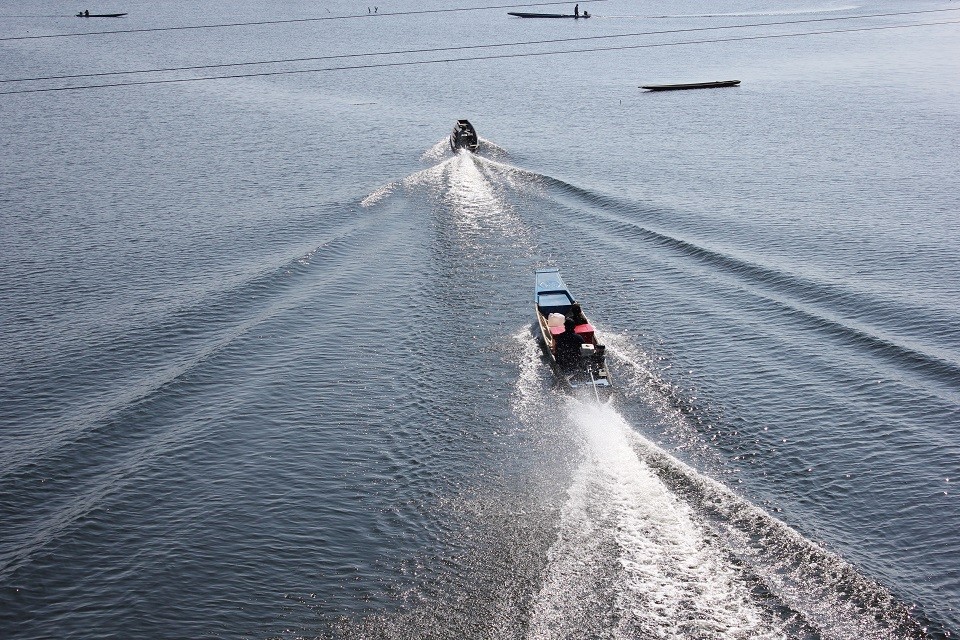
Photo: Jonas Holmqvist
Illegal logging
In 2010, the Village Forestry Association (VFA) paid dividends of approximately $200,000 per household. The 2011’s dividend payment in the amount US$200,000 was planned to make on a per shareholder basis (all resettlers, including children, are stakeholders). It means the payments would vary depending on the number of household members. It is supposed to be institutionalized and actually the VFA made efforts to finalize its legal status as a limited liability company for a long run of the resettlers’ interests. Unfortunately, it did not last long. Since April 2012, there have been no dividends paid to resettlers anymore because of a management change, pressure from illegal timber harvesting, encroachment by villagers onto its land for agriculture, high levels of taxation of its timber, and delayed payment of debts owed by its only client, Luen Fat Hong (LFH). What’s worse, unless rapid and effective steps are taken to right the situation the forestry will deteriorate further. More or less one third of the villagers’ income stems from this pillar. It is definitely not in accordance with the target of sustainability that the harvesting and utilization of the timber have been inefficient and have produced serious waste. The marketing has been inadequate and the endeavours to meet market demands seriously flawed. There has been little success in the few attempts to begin the process.
Disappointing agriculture
Dramatically different from the update, which stated that the allocation of village lands has led to an agricultural income increase for villagers, the report argues that agriculture is disappointing because the land is lowly utilized by the resettlers due to various reasons. Some factors mentioned are insufficient fertilizer for soils, harm from human and animal raiders to the plots, and preoccupation with fishing and timber poaching (The resettlers tend to prefer the more remunerative and less labor-intensive pursuits to the pumped irrigation and intensive farming practices systems, which are totally foreign to the resettlers). But even worse, the use of the largest allocation of land to the resettlers is declining, not growing. Given the fact that the resettlers already lack motives to spend a lot of time on the agriculture, the decline further undermines the sustainability of this pillar.
On this issue, the update briefly states that in the implementation of Land Use Planning and Village Development Plans, villagers are allowed to discuss the resources and opportunities available to them, and agree on a set of priorities. It means the resettlers are given more authority to decide on the use of land, which has made quite a bit of progress. Nevertheless, in the view of the report, the authority given to the villagers might not be sufficient to increase the productivity of the land in compliance with their genuine will, under the context of status quo of Laos, one of the most corrupt countries in the world. Their opinions might be frequently swayed by different interest groups. The freedom and rights of the resettlers can also be easily abused by the authority.
Difficult to measure off-farm
In the view of the update, many attempts are made to boost micro-business. Off-farm businesses are eligible for financial support from the Village Credit Funds and vocational training courses on off-farm skills are offered to the interested villagers. However, the POE believes that not enough resettlers are undertaking such courses. Owing to the absence of the income figures, it is impossible for them to estimate that whether this pillar has met the certain targets or not. The expansion of tourism creates new opportunities for off-farm business and employment and tourist numbers in Khammouane Province have doubled in two years to 42,700 in 2013. Nevertheless even the update admits that prospects for growth of this sector are not very promising. The challenge lies in that the relevant partners would need to come up with a balance between the development with potential benefits and potential associated negative impacts for the local environment.
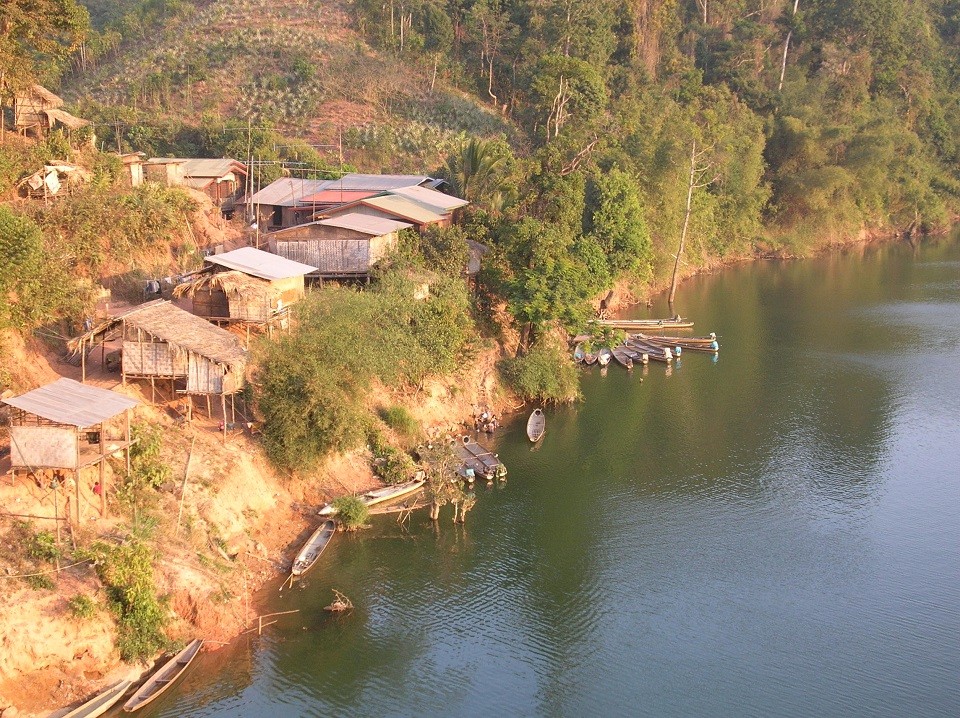
Village downstream of the Nam Theun 2 dam, photo: Andrew Preston
Conclusion
In a nutshell, through the comparison of these two documents, it would be naive to reckon that the resettlement can be made once and for all. The comparison is not adequate to prove the two documents are self-contradictory inherently, either. It does make sense that the project was proceeding successfully in the past years because the Lao authorities, Nam Theun 2 Power Company, along with their development partners, took a proactive approach in addressing the environmental and social impact of the dam. Nevertheless, in some occasions relevant mechanisms might not be in place for compensating impacted people and securing sustainable development of the local livelihood, which explains that why many weaknesses could be found by the report.
A more convincing explanation why these two documents give the illusion that they are conflicting is that they concentrate on different sides of the same coin. The update is more focused on the positive aspects of the project and the report is reverse. Continuous attention and endeavours should be put into this long-term project even though the closing of Resettlement Implementation Period is agreed on by stakeholders in the update, otherwise the resettlers’ due rights and interests might be violated easily. Different from Thayer Scudder’s (member of POE) opinion that “the task of building a large dam is too complex and too damaging to priceless natural resources”, the author holds a “cautiously optimistic” attitude towards building large dams. With more and more attention paid to the environmental impacts and human rights issues, people are likely to get closer to a better balance of social effects and economic effects in terms of hydropower construction. Maybe it is in question that Nam Theun 2 is capable to serve as a new model for sustainable hydro-power, since there still leaves much room to improve from the environmental and social perspectives. But it expressively shows the determination and efforts to “do a better dam”.
Fan Li is an intern at the Fivas office in the fall of 2015. He is a master student at the Norwegian Centre for Human Rights at the University of Oslo.

